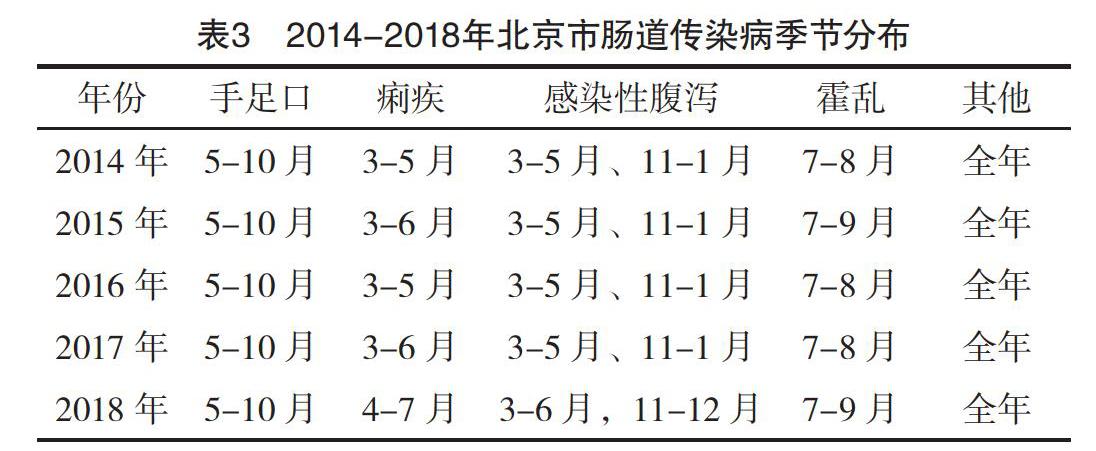2014-2018年北京市肠道传染病的调查研究
李晖



【摘要】 目的:調查2014-2018年北京市肠道传染病流行特征,为防控策略的制定提供参考。方法:依据北京市各级医疗机构传染病上报系统,获取2014-2018年北京市肠道传染病数据,分析北京市肠道流行病学特征。结果:2014-2018年北京市法定的肠道传染病报告病例数由28 944名增加至68 382名,在全部传染病中所占比例持续上升;肠道传染病分布类型以手足口、感染性腹泻及痢疾等为主,手足口多发于每年5-10月,痢疾多发于每年4-5月份,感染性腹泻则分别在3-5月、11月-次年1月发病率最高,霍乱多发于每年7-8月。手足口主要发病群体为5岁以下儿童,感染性腹泻主要发病群体为12岁以下儿童,其他各肠道感染病年龄分布比较均匀;每年男性肠道传染性疾病发病率明显高于女性,每年城乡结合部肠道传染性疾病发病率高于城镇居民。结论:2014-2018年北京市法定肠道传染病报告例数呈现出上升趋势,其中手足口疫情占较大比例,痢疾、感染性腹泻等发病趋势相对平稳。肠道传染病以5-10月份为高发季节,低龄儿童为主要发病人群,北京市肠道传染病疫情仍然比较严重,需要加强疫情防控措施。
【关键词】 肠道传染病 流行病学特征 防控
Investigation and Study on Intestinal Infectious Diseases in Beijing From 2014 to 2018/LI Hui. //Medical Innovation of China, 2020, 17(04): 080-083
[Abstract] Objective: To investigate the epidemic characteristics of intestinal infectious diseases in Beijing from 2014 to 2018, and provide references for the formulation of prevention and control strategies. Method: According to the infectious disease reporting system of medical institutions at all levels in Beijing, the data of intestinal infectious diseases in Beijing from 2014 to 2018 were obtained to analyze the epidemiological characteristics of intestinal diseases in Beijing. Result: From 2014 to 2018, the number of reported cases of intestinal infectious diseases in Beijing increased from 28 944 to 68 382, accounting for a continuous increase in the proportion of all infectious diseases. The distribution types of intestinal infectious diseases were mainly hand, foot and mouth diseases, infectious diarrhea and dysentery. The incidence of hand, foot and mouth diseases was more common from May to October, dysentery was more common from April to May, infectious diarrhea was the highest from March to May, November to January, and cholera was more common from July to August. The main incidence group of hand, foot and mouth diseases was children under 5 years old, the main incidence group of infectious diarrhea was children under 12 years old, and the age distribution of other intestinal infections was relatively uniform. The annual incidence of intestinal infectious diseases in men was significantly higher than that in women, and the annual incidence of intestinal infectious diseases in urban and rural areas was higher than that in urban residents. Conclusion: From 2014 to 2018, the number of reported cases of statutory intestinal infectious diseases in Beijing showed an increasing trend, among which the cases of hand, foot and mouth diseases accounted for a large proportion, while the incidence of diarrhea, infectious diarrhea and other diseases was relatively stable. The incidence of intestinal infectious diseases is high from May to October, with young children as the main population. The epidemic situation of intestinal infectious diseases in Beijing is still relatively serious, so prevention and control measures should be strengthened.
[Key words] Intestinal infectious diseases Epidemic characteristics Prevention and control
First-authors address: Beijing Municipality Chui Yang Liu Hospital, Beijing 100022, China
doi:10.3969/j.issn.1674-4985.2020.04.020
肠道传染病是由于病毒、细菌及寄生虫所引起的经消化道传播的疾病,我国疾控中心法定的传染病中,肠道传染病包括手足口病、痢疾(细菌性痢疾、阿米巴性痢疾)、脊髓灰质炎、霍乱及其他感染性腹泻等[1-3]。近年来随着国家疾病防控力度的增加,传染病防控水平明显提高,并取得显著的效果,然而以手足口为主的肠道传染病防控效果并不被理想[4-7]。北京市作为国家政治、经济中心,人口流动性大、外来人员众多,人口素质参差不齐,肠道传染病发生率仍然较高,在疾病谱中占有相当大的比例[8-9]。为了解北京市肠道传染病的流行趋势、流行特征,本文从中国疾病预防控制信息系统获取资料,了解2014-2018年北京市肠道传染病流行病学特点,明确需要解决的问题,并为北京市防控策略提供依据,现报道如下。
1 资料与方法
1.1 资料来源 选择北京市城镇、城乡结合部居民作为研究对象,自中国疾病预防控制信息系统内下载2014-2018年肠道传染病的疫情资料。
1.2 方法 将资料导入Excel软件进行整理、归类并分析。分析2014-2018年北京市肠道传染病总体趋势、类型、季节、年龄、性别及区域分布情况。
2 结果
2.1 2014-2018年北京市39种法定传染病发病数及肠道传染病总体趋势 2014年-2018年北京市肠道传染病发病例数由28 944例增加至68 382例,年平均增加约7 887例,5年平均发病率约为42 765/(10万),肠道传染病在总法定传染病中占据比例呈逐年上升趋势。见表1。
2.2 死亡率 法定肠道传染病死亡病例共计49例,其中重症手足口30例(61.22%),痢疾8例(16.33%),其他11例(22.45%)。
2.3 2014-2018年北京市肠道传染病类型 手足口在肠道传染病中占据比例最高,且每年持续上升,其次为痢疾及感染性腹泻,见表2。
2.4 2014-2018年北京市肠道传染病季节分布 手足口多发于每年5-10月,痢疾多发于每年4-5月份,感染性腹泻则分别在3-5月、11月-次年1月发病率最高,霍乱多发于每年7-8月,见表3。
2.5 2014-2018年北京市肠道传染病年龄分布 不同疾病的主要年龄分布不同,其中手足口以5岁以下儿童为主要发病群体,2014年、2015年、2016年、2017年、2018年中,占据比例分别为70.21%(8 679/10 362)、69.94%(9 282/13 271)、65.55%(13 028/19 876)、72.69%(18 729/25 764)及74.13%(29 647/39 992);感染性腹泻以12岁以下儿童为主要发病群体,2014年、2015年、2016年、2017年、2018年中,占据比例分别为62.37%(3 987/6 392)、58.09%(3 718/6 400)、45.37%(3 189/7 029)、47.11%(3 251/6 901)及28.20%(2 900/10 285)。其他肠道感染病各年龄分布比较均匀。
2.6 2014-2018年北京市肠道传染性疾病性别分布 每年男性肠道传染病发病率均高于女性,见表4。
2.7 2014-2018年北京市肠道传染性疾病区域分布 每年城乡结合部肠道传染性疾病发病率均高于城镇居民。见表5。
3 讨论
肠道传染病是导致儿童生长发育障碍、营养不良以及成人劳动力严重下降的主要因素之一[10-12]。近年来,我国多地爆发手足口疫情,关于其发病特征,临床时有报道,而重症手足口患儿预后较差,死亡率、后遗症率相对较高,已经成为社会主要卫生安全问题[13-15]。流行病学统计数据显示,全球每年感染性腹泻发生病例多达20亿,其中以2岁以下儿童为主,同时腹泻为5岁以下儿童营养不良的主要原因,是其死亡的第2大原因,因此加强肠道传染病的流行病学监测,掌握其发病规律、分布特点等,并針对性的采取防控策略尤为重要[16]。
卫生部下发《卫生部关于将手足口病纳入法定传染病管理的通知》后,北京市加强手足口病的监测、管理以及防控,而疫情报告质量明显提高[17-18]。手足口发病率逐年升高,分析与二胎政策放开、监管网络更加完善、成熟有关。手足口是由以肠道病毒71型、科萨奇A组16型为主的肠道病毒引起的急性传染病,多发于学龄前儿童,其中3岁以下年龄组的发病率最高;在对肠道传染病死亡率统计时发现,重症手足口为主要病死原因,通过分析医院上报数据、医院随访等发现,患儿发病时间均在10 d以上,且伴有持续高热、神经系统、呼吸系统表现等,患者死亡原因为脑膜炎、肺水肿、脑脊髓炎等,在对死亡患儿家庭构成进行分析时发现,28例患儿由爷爷奶奶抚养,且其中26例为外来人员,由此可见,虽然北京市疾控中心、医院及基层医疗机构加强了手足口健康知识宣传及教育,然而部分外来务工人员文化水平较低,缺乏相关医疗知识,为传染病知识教育的洼地,因此在往后的传染病防控中,需要加强这部分人员的关注度。从本文结果可以看出,2014-2018年5岁以下儿童手足口发病率处于较为平稳的状态,分析认为与北京市幼教机构加强手足口疫情防控有关,虽然整体手足口发病率呈现出逐渐上升趋势,然而低龄幼儿发病率得到一定程度的控制,这对减少重症手足口、死亡病例有着重要意义。感染性腹泻的发生多存在集体性特征,多发生于学前教育机构、中小学等,近5年来北京市儿童感染性腹泻发生率所占比例整体呈现出下降趋势,分析认为与《北京市感染性腹泻流行情况及防控策略》发布有关[19]。与其他肠道传染病比较,手足口、感染性腹泻等疾病,发病呈现出低龄化趋势,这与该人群的生活特点相关,如活动方式、个人卫生及体质等。

